Economics: Pricing, Demand, and Economic Efficiency—A Primer
Basic Economic Concepts: Highway Supply and Demand
This section introduces some of the basic economic principles that provide a foundation for understanding the economic rationale for congestion pricing, discussed in the following sections. Key concepts include:
- The explicit and implicit costs associated with highway travel;
- The demand for using highway facilities;
- Basic relationships of traffic volumes and traffic flow; and
- The interaction of supply and demand to determine traffic volumes and highway user costs.
The Cost of Travel
We live in a world of scarcity, meaning that resources are not unlimited. As a result, when we consume a good or service, we forego the opportunity to consume something else. Economists refer to this as an “opportunity cost,” and it is perhaps the most fundamental concept in all of economics. In an important sense, the “price” that people pay for consumption is this opportunity cost.
For most goods and services, the price that consumers pay is simply the out-of-pocket monetary cost to the user; the foregone opportunity would be to spend that money on something else. However, economists have also recognized that consumption requires time as well as money, which is itself in limited supply. This insight has been useful in analyzing the demand for time-saving devices (e.g., microwave ovens) and recreational services, among many others.
For highway travel, the time spent in transit is one of the most critical components of the price that users face. Time spent in travel is time that could be devoted to other pursuits, such as earning income or engaging in leisure activities. The value of these other pursuits represents the opportunity cost of travel time.
Safety is another implicit cost associated with highway travel. When people choose to travel, they also take on the risk of property damage, injuries, or even death due to crashes. These risks can be valued based on the willingness of people to pay for reducing the risk of such adverse outcomes.
Other types of costs borne by highway users do represent actual, direct costs. Vehicle operating costs include such items as fuel, oil, tires, maintenance, and depreciation. Travel-related taxes and tolls represent another direct cost to users. In the case of cash or coins paid at toll booths, these can literally be “out-of-pocket” costs.
The preceding discussion of user costs is based on the predominant form of highway use, namely individuals driving or riding in privately owned passenger vehicles. Similar considerations hold for commercial vehicles, with two key exceptions. First, the value of time for drivers is a direct cost rather than an implicit one, because the drivers are being paid for their services. Second, the user cost for truck transportation also includes the time value of the cargo while in transit.
The Demand for Highway Travel
The demand for highway transportation represents the value that consumers place on traveling in a particular time, manner, and place, as measured by their willingness to “pay” for a trip. Some trips will be valued very highly, whereas others will be valued much less so. This relationship between the cost of travel and the level of demand for travel is commonly depicted as the travel demand curve (see Exhibit 1).
Graph. Exhibit 1: The travel demand curve. The graph shows a straight line sloping downward from left to right, indicating that as the cost of highway travel (y axis) decreases, the traffic volume (x axis) decreases as well.
The travel demand curve slopes downward, reflecting a basic economic truth: As the price of a good or service falls, the quantity that will be demanded increases, holding other factors constant. The demand for travel is no different: When the price of travel is high (in the generalized user-cost sense described above), fewer people will be willing to make fewer trips; when that price falls, there will be more people willing to make more trips.
The demand curve is characterized by two important qualities: its level and its shape. The level of demand (i.e., the position of the demand curve) is affected by a number of factors. For example, each trip has an origin and a destination. The more people there are at a particular origin and the more activities (e.g., shopping or employment) there are at a particular destination, the more will routes between the origin and destination be in demand for travel. As income levels rise, the willingness to pay for travel also increases, shifting the demand curve outward. Demand levels can also vary significantly (and importantly for the discussion here) by time of day, due to the simple fact that people prefer to sleep at night and be active during the day, leading to higher levels of demand for travel in the morning and early evening and lower levels of demand during mid-day and overnight hours. Finally, subjective qualities such as comfort and convenience can affect the level of demand.
The responsiveness of the quantity of travel demanded to changes in the price of travel is measured by travel demand elasticity. Mathematically, it is simply the percentage change in quantity demanded divided by the percentage change in price. Intuitively, elasticity represents the shape of the demand curve. If the quantity demanded changes significantly in response to small changes in price, demand is said to be relatively elastic; thus, the demand curve is fairly flat. Conversely, if demand changes only slightly in response to large changes in price, demand is said to be relatively inelastic; thus, the demand curve will be relatively steep. At the extremes, demand can be said to be perfectly elastic (i.e., any change in price results in an infinite change in quantity demanded) or perfectly inelastic (i.e., any change in price results in no change in quantity demanded).
The elasticity of demand also depends on a number of factors. Perhaps most important is the timeframe being considered: Demand is typically less elastic in the short run than in the long run. When the price of travel changes significantly (as it has recently with large runups in fuel prices), travelers initially have relatively few opportunities for adjusting their behavior. They may decide not to make some trips or to change their mode of travel to work, but their housing and employment locations, key determinants of the level of travel, are likely to remain fixed initially. In the long run, however, everything is variable. People may choose to move closer to their work or take jobs closer to home. Commercial real estate development patterns may also respond to reduce the distance between consumers and activity centers. As a result, the long-term impact of an increase in travel costs on the volume of highway may be much higher than the short-term impact.

The elasticity of demand is also affected by the quality and availability of close substitutes. For example, if two companies make very similar products, then consumers are likely to readily switch from one product to the other in significant numbers if the price of one of the products changes, resulting in high-demand elasticity for each product. Conversely, if there are no good substitutes for a good or service, then consumers might simply be faced with a choice between paying a higher price or going without, in which case demand is likely to be inelastic.
For highway travel, public transit use can often serve as a reasonable alternative to highway use. In general, the higher the quality of that service (such as frequency and convenience), the better a substitute it will be to driving and the more elastic highway travel demand will be. Telecommuting can also serve as a substitute for highway commuting during peak periods; the more readily it is offered by employers, and the better it is at substituting for time spent in an office (e.g., through high-quality telecommunications), the more highway travel will respond to changes in the cost of travel.
The Supply Side
In determining market outcomes, supply is the counterpart to demand. For most goods and services, supply is simply related to production: how many toys will be fabricated, how many tennis lessons will be taught, etc. For highway travel, however, the relationship is more complicated. The highway infrastructure may be built and maintained by a public agency or private entity, but consumers supply the vehicles (and their persons) to travel on that infrastructure. In order to understand the supply side of highway travel, it is first helpful to review some basic principles of traffic flow and how highways become congested.
Traffic engineers typically characterize traffic flow as a relationship between travel speeds, traffic volumes, and traffic density (e.g., number of vehicles occupying a given space on the road). Exhibit 2 shows the general shape of these relationships.
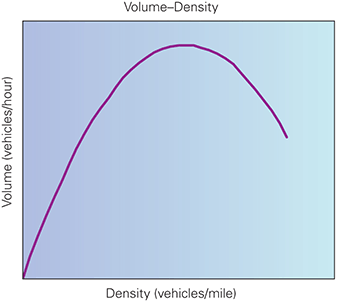
Graph. Exhibit 2: Fundamental traffic flow relationships. Relationship between volume (y-axis; in vehicles/hour) and density (x-axis; in vehicles/mile). The graph shows a curve that moves up from the origin at a steep angle from left to right and then peaks almost to the top of the y-axis and in the middle of the x-axis. The curve then begins to slope downward at the far right side of the graph, stopping almost halfway down the graph. This indicates that up to a certain point, as the number of vehicles/hour on the road increases, the density of the traffic will increase as well. As the density of the vehicles on the road increases, the volume of vehicles/hour begins to decrease.
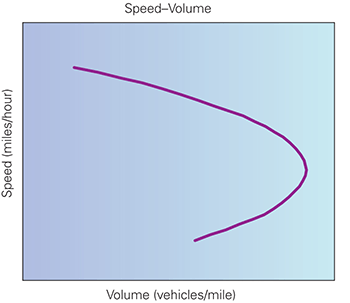
Graph. Exhibit 2: Fundamental traffic flow relationships. Relationship between speed (y-axis; in miles/hour) and volume (x-axis; in vehicle/mile). The graph shows a side-way J-shaped curve that opens to the left. At high speeds (y-axis), the traffic volume (x-axis) is relatively low. As the volume increases, the speed at which the vehicles can travel gradually decreases until it reaches a point in which the volume begins to decrease as the speed continues to decrease as well.
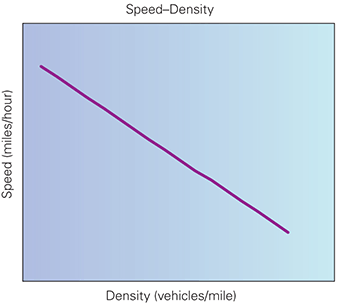
Graph. Exhibit 2: Fundamental traffic flow relationships. Traffic flow relationship between speed (y-axis; in miles/hour) and density (x-axis; in vehicles/mile). The graphic shows a straight line moving downward from left to right, indicating that as the density of the vehicles on the road increases, the speed at which they are traveling decreases.
Exhibit 2. Fundamental traffic flow relationships.
When traffic volumes are very low, vehicles have minimal impact on one another, and their travel speeds are limited only by traffic-control devices and the geometry of the road. As traffic volumes increase, however, traffic density increases, and the freedom for vehicles to maneuver is more constricted. As a result, travel speeds begin to decline, relatively slightly at first, but falling significantly as traffic volumes approach the maximum capacity (service flow rate) on the facility. As traffic density continues to increase beyond this saturation point, the speed–volume relationship actually bends backward, as traffic flow breaks down and fewer vehicles are able to get through.
The decline in travel speeds as traffic volumes approach roadway capacity, of course, is what we all know as congestion delay. The important implication of this is that there will be a relationship between highway-user costs and traffic volumes on a particular road. At lower volumes, user costs will be relatively constant with respect to volume. As traffic volumes increase, however, user costs will eventually begin to rise at an increasing rate; the point at which this occurs depends on the capacity of the road (see Exhibit 3). This relationship is sometimes referred to as a generalized user cost curve.
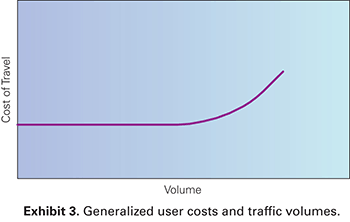
Graph. Exhibit 3: Generalized user costs and traffic volumes. The graph displays the generalized user costs and traffic volumes as measured by volume (x-axis) and cost of travel (y-axis). The graph shows a straight line, beginning one-third of the way up the y-axis, and moving horizontally from left to right before beginning to curve upward in the middle of the x-axis. This indicates that when traffic volume is low, the cost of travel remains constant, but as the volume increases, the cost will gradually begin to increase as well.
Market Equilibrium
When supply and demand are in balance, a market is said to be in equilibrium. This is often represented as the intersection of a supply curve and a demand curve, which determines the market-clearing price and quantity (see Exhibit 4). At this point, everyone who purchases the good is willing to (collectively) buy that amount at that price, and producers are willing to supply that quantity at that price. If either the supply or demand curves shift, the market price and quantity will also change.
For highway travel, demand is determined as described above. The “supply” curve, however, is essentially represented by the generalized cost curve. The intersection of these two curves determines how high traffic volumes will be and what the associated average highway-user costs will be at that volume level. When the level of demand is low relative to the capacity of the road, it will be uncongested, and prices will be relatively constant even as volumes increase (the “flat” part of the user cost curve in Exhibit 4). However, when demand levels are high and the road is congested, both user costs and traffic volumes will be higher, potentially rising sharply as demand continues to increase.
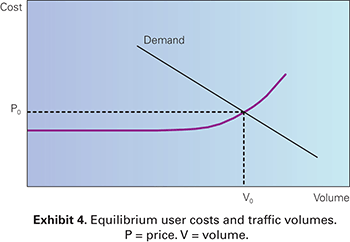
Graph. Exhibit 4: Equilibrium user costs and traffic volumes. The graph shows two solid lines. One line begins one-third of the way up the y-axis (cost) and moves straight in a horizontal line from left to right before beginning to curve upward two-thirds of the way across the x-axis (volume), indicating that when traffic volume is low, the cost of travel remains constant, but as the volume increases, the cost will gradually begin to increase as well. The other line is a straight line that represents demand. This line slopes downward from left to right, showing that as cost decreases and volume increases, demand also decreases. The graph also has two dotted lines (one that moves horizontally from the y-axis, P0, and one that moves vertically from the x-axis, V0) that meet at the point where the first solid line (user cost) and the second solid line (demand) intersect. This represents the equilibrium point at which supply and demand are in balance.